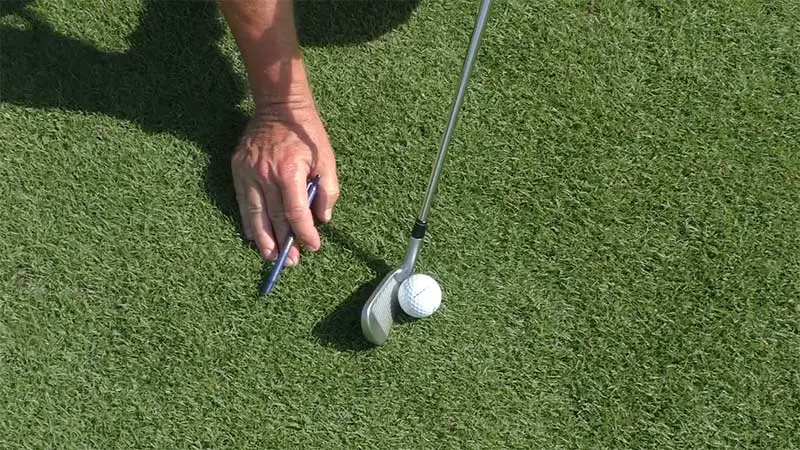Every golfer dreads the infamous shank. It’s one of the most frustrating and destructive faults that can plague your game, often leading to higher scores and a lot of heartache.
Understanding the common causes of golf shanks can be your first step towards eliminating this pesky problem for good.
Shanking the ball happens to everyone, and it’s never a fun experience. The mystery behind why it happens can make it even more aggravating, often causing you to repeat the mistake.
By grasping the root causes and implementing proper fundamentals and practice techniques, you can finally put an end to those errant shots and improve your ball-striking consistency.
Fundamental Causes of Golf Shanks
Understanding the fundamental causes of golf shanks is key to improving your game and hitting cleaner shots. Let’s delve into some common reasons why golfers experience shanks and how to address them.
Incorrect Stance and Posture
Standing too close. A crowded stance can lead to a shank as your arms seek space during your swing. Ensure there’s adequate distance between you and the ball, maintaining a balanced posture. Hunching over.
Poor posture results in inconsistent swings. Keep your back straight and knees slightly bent, promoting a smoother swing path. Grip issues.
An overly tight or incorrect grip can also contribute to shanks. Make sure your grip is firm yet relaxed, allowing for better control and smooth movement through your swing.
Inadequate Grip on the Club
Holding too tight. Excessive grip pressure can cause tension in your swing, leading to a shank. Aim for a grip that’s firm but relaxed, allowing fluid motion.
Wrong hand placement. Incorrect hand positioning disrupts your swing path. Make sure you see more knuckles on your left hand if you’re right-handed, providing better control.
Standing too close to the ball. This can limit your swing space, causing you to hit the hosel. Maintain a proper distance to ensure a more accurate strike. Poor weight distribution.
Uneven weight can throw off your balance, leading to inconsistent contact. Focus on even weight across both feet to optimize your alignment.
Improper Ball Positioning
Too far forward. Placing the ball too far forward in your stance can lead to hitting the hosel. Center the ball between your feet to encourage a more accurate strike.
Too far back. Positioning the ball too far back results in a steep swing path, increasing the risk of shanks. Adjust the ball to a more neutral position for improved contact.
Technical Mistakes Leading to Shanks
Understanding technical mistakes can help pinpoint why shanks happen and how to fix them.
The Inside-to-Outside Swing Path
An inside-to-outside swing path can lead to shanks. When your club moves too far inside the target line during the backswing and follows an exaggerated outward motion during the downswing, it often results in contact with the hosel.
This path is commonly caused by poor takeaway, incorrect weight shift, or overactive hands, which can make your clubhead travel excessively inside. Placing an alignment stick outside the ball can help correct this path quickly.
Over-the-Top Swing Motion
An over-the-top swing motion is a frequent culprit behind golf shanks. This occurs when your downswing is steeper than your backswing, causing the club to approach from outside the target line.
It often results from a lack of proper weight transfer, overly aggressive upper body movement, or poor sequencing between the hips, torso, and arms.
This motion tends to produce slices or shanks. Ensuring your lead elbow relaxes and folds properly on the forward swing can help generate a more neutral clubface and reduce the likelihood of shanking.
Excessive Weight Transfer
Excessive weight transfer during your swing can also lead to shanks. When you hang back instead of properly shifting your weight, it throws off your balance.
This usually happens due to improper lower body movement or rushing the transition from backswing to downswing.
Using drills like the Wall Drill, where you keep your rear end lightly touching a wall throughout the swing, can maintain proper hip rotation and prevent early extension, helping you avoid shanks.
Equipment-Related Influences
Sometimes, your golf shanks can be traced back to issues with your equipment.
Using the Wrong Club
Selecting the right club is crucial. Using a club that doesn’t match your skill level or swing type can cause inconsistent contact.
For instance, if you use a club with a shaft that’s too stiff, you might struggle to time your swing correctly, leading to shanks.
Additionally, clubs that are too short or long for your height can affect your stance and swing path, making it more challenging to hit the ball squarely.
Equipment Misfit and Its Effects
Using equipment that doesn’t fit your physique can lead to shanks. Improper lie angles, incorrect grip sizes, and unsuitable clubhead designs all contribute.
If your clubs are not custom-fitted, you could find yourself making compensations in your swing, which increases the chance of shanking the ball.
Leveraging a professional fitting session ensures you have clubs tailored to your measurements and swing dynamics, aiding in more consistent and accurate shots.
Psychological Factors
Psychological factors can indeed play a role in the occurrence of golf shanks, though they are often intertwined with technical issues.
Here are some psychological factors that might contribute:
Mental Pressure Impacting Swing
Pressure can greatly affect your swing. When you face high-stress situations like crucial shots, your body might tense up.
This tension can restrict your natural movement, leading to shanks. Handling stress is essential to maintain a fluid swing.
Practicing deep breathing techniques and focusing on staying relaxed can help keep your nerves in check. Moreover, improper club grip can contribute to shanks.
A grip that’s too tight or awkward can disrupt the clubface’s alignment at impact. Ensure your grip is firm but relaxed for optimal control.
Lack of Focus During the Swing
Distractions easily lead to shanks. Losing focus at any point in your swing disrupts your timing and coordination. Simple errors like looking up too soon to see where the ball is going can cause inconsistent contact.
Maintain concentration by establishing a pre-shot routine. This routine centers your attention and reinforces consistency. Moreover, grip pressure plays a significant role.
Holding the club too tightly restricts the fluidity of your swing, resulting in mis-hits. Keep a relaxed grip to ensure a smoother follow-through.
Practical Tips to Prevent Golf Shanks
Shanking the golf ball can be frustrating, but don’t worry. Here are some practical tips to help you prevent golf shanks effectively.
Adjusting Your Stance and Posture
Maintaining the right stance and posture is crucial to prevent shanking. Your body should align from the top of your head to your toes.
Make sure your weight is evenly distributed to stay grounded. Keep a slight bend in your knees and avoid locking them.
If you feel like you have to reach forward for the ball, adjust your stance and move closer. Good posture uses correct alignment to help you make solid contact with the ball and prevent a shank.
Correcting Your Grip and Ball Position
Ensuring you have the proper grip and ball position can eliminate shanks. Check that your grip is neither too tight nor too loose. Position the ball slightly forward of the center to promote an ideal contact point.
If your grip and ball position are inconsistent, you’re more likely to strike the ball with the hosel, causing shanks. Proper grip and ball placement set you up for a better, more controlled swing.
Developing a Consistent Practice Routine
A consistent practice routine helps in building muscle memory and reducing shanks. Incorporate drills like the Wall Drill and the Foot Spray Drill in your practice.
The Wall Drill promotes proper hip rotation, while the Foot Spray Drill helps you analyze impact marks on the clubface to adjust your swing accordingly.
Regular practice helps you develop a rhythm and improves overall swing mechanics, making shanking less likely. Practice diligently and focus on these drills to see significant improvements in your game.
Frequently Asked Questions
How can I mentally recover from shanking in golf?
To mentally recover from shanking in golf, try not to focus on the negative outcome. Stick to your routine, accept the consequences, and focus on the next shot.
Why do the shanks keep returning?
Shanks often return due to improper posture and spacing. Poor posture and being too crowded relative to the arms and the body can cause the arms to seek space, leading to shanks.
Why do I keep shanking to the right?
You may keep shanking to the right if your hands are too far out in front of you during your swing. This can cause you to hit the hosel even if your swing path is correct.
How can I stop shanking according to Butch Harmon?
To stop shanking, Butch Harmon suggests swinging out and correcting a closed clubface. Using the head cover drill can also help prevent shanks.
Does a flat swing cause shanks?
Yes, one of the leading causes of a shank is a golf swing that becomes too flat on the downswing.
Conclusion
Understanding the causes of golf shanks is crucial for improving your game. By focusing on your stance, grip, and ball positioning, you can address fundamental issues.
Correcting your swing path and weight transfer will also prevent technical mistakes. Implementing practical tips like adjusting your posture and practicing with drills can build muscle memory and enhance your swing mechanics.
With consistent practice and attention to these details, you’ll reduce the occurrence of shanks and enjoy a more successful golfing experience.
Additionally, mental aspects such as concentration and confidence play a significant role. Regularly reviewing your technique and seeking professional coaching can provide continuous improvement and prevent the return of common mistakes.








Colin McCarthy